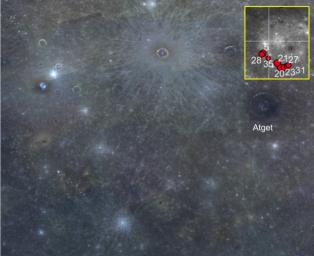Ring of Fire
Caption:
Here is a color view of the southern part of the
Caloris basin
. Extending along the southern rim are a number of pyroclastic deposits that have
a distinctive reddish color
. The inset locator map shows the entire Caloris basin; the red dots correspond to mapped pyroclastic deposits, which formed during
explosive volcanic eruptions
. On the Earth, volcanoes are often associated with boundaries where tectonic plates interact. The Pacific "Ring of Fire" is a famous example of volcanism found at plate boundaries. Mercury, by contrast, is a one-plate planet. Instead, mercurian volcanism is largely controlled by fracturing or tectonic features related to impact basins and craters. Caloris's southern rim is a partial "ring of fire."
This image is part of MDIS's high-resolution 3-color mosaic. The 3-color campaign is a major mapping activity in MESSENGER's extended mission. It complements the 8-color base map (at an average resolution of 1 km/pixel) acquired during MESSENGER's primary mission by imaging Mercury's surface in a subset of the color filters at the highest resolution possible. The three narrow-band color filters are centered at wavelengths of 430 nm, 750 nm, and 1000 nm, and image resolutions generally range from 100 to 400 meters/pixel in the northern hemisphere. The inset is part of Fig. 4 of L. Kerber
et al.,
(2011),
Planet. Space Sci.
59
, 1895-1909.
Instrument:
Wide Angle Camera (WAC) of the Mercury Dual Imaging System (MDIS)
WAC filter:
9, 7, 6 (1000, 750, 430 nanometers) in red, green, and blue.
Center Latitude:
22.8°
Center Longitude:
156.9° E
Resolution:
1000 meters/pixel
Scale:
Atget, the dark-floored crater near the right edge, is 100 km (62 mi.) in diameter.
Background Info:
The MESSENGER spacecraft is the first ever to orbit the planet Mercury, and the spacecraft's
seven scientific instruments and radio science investigation
are unraveling the history and evolution of the Solar System's innermost planet. Visit the
Why Mercury?
section of this website to learn more about the key science questions that the MESSENGER mission is addressing. During the one-year primary mission, MDIS acquired 88,746 images and extensive other data sets. MESSENGER is now in a year-long extended mission, during which plans call for the acquisition of more than 80,000 additional images to support MESSENGER's science goals.
For information regarding the use of images, see the MESSENGER
image use policy
.
Cataloging Keywords:
| Name |
Value |
Additional Values |
| Target |
Mercury |
|
| System |
|
|
| Target Type |
Planet |
|
| Mission |
MESSENGER |
|
| Instrument Host |
MESSENGER |
|
| Host Type |
Orbiter |
|
| Instrument |
Mercury Dual Imaging System (MDIS) |
|
| Detector |
Wide Angle Camera (WAC) |
|
| Extra Keywords |
Color, Crater, Impact, Map, Radio, Volcano |
| Acquisition Date |
|
| Release Date |
2013-01-09 |
| Date in Caption |
|
|
| Image Credit |
NASA/Johns Hopkins University Applied Physics Laboratory/Carnegie Institution of Washington |
| Source |
photojournal.jpl.nasa.gov/catalog/PIA16676 |
| Identifier |
PIA16676 |

 Planetary Data System
Planetary Data System
